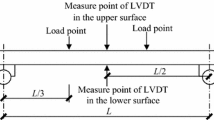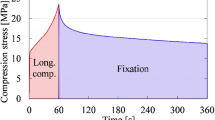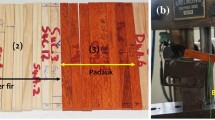Summary
An adaptor for the conversion of a high-accuracy tensile creep machine to compression loading is described. It was found that a stable mechano-sorptive creep limit could be obtained by a suitable load reduction after moisture cycling; after which further creep and creep recovery just balanced each other. In this stable state the value of the longitudinal moisture-swelling coefficient depended on the strain; being less with tensile strain and more with compressive strain then in the unloaded condition. These differences in the swelling coefficient could explain the apparent recovery during subsequent sorptions in mechanosorptive creep in bending. Such a hypothesis was strongly supported by numerical comparisons of strains in bending, tension and compression.
Similar content being viewed by others
References
Arima, T.; Grossman, P. 1978: Recovery of wood after mechano-sorptive deformation. J. Inst. Wood Sci. 8: 47–52
Armstrong, L. 1972: Deformation of wood in compression during moisture movement. Wood Sci. 5: 81–86
Armstrong, L.; Kingston, R. 1960: The effect of moisture changes on creep in wood. Nature 185: 862–863
Barkas, W. 1949: The swelling of wood under stress. London: HMSO
Bazant, Z.; Meiri, S. 1985: Measurements of compression creep of wood at humidity changes. Wood Sci. Technol. 19: 1–4
Boyd, J. 1982: An anatomical explanation for viscoelastic and mechano-sorptive creep in wood, and effects of loading rate on strength. In: Baas, P. (Ed.). New perspectives in wood anatomy. pp. 171–222. Hague: Nijhoff/Junk
Darlington, M.; Saunders, D. 1970: An apparatus for the measurement of tensile creep and contraction ratio in small non-rigid specimens. J. Phys. (E) 3: 511–514
Gressel, P. 1984: Zur Vorhersage des langfristigen Formänderungsverhaltens aus Kurz-Kriechversuchen. Holz Roh-Werkstoff 42: 293–301
Gressel, P. 1986: Vorschlag einheitlicher Prüfgrundsätze zur Durchführung und Bewertung von Kriechversuchen. Holz Roh-Werkstoff 44: 133–138
Grossman, P. 1976: Requirements for a model that exhibits mechano-sorptive behaviour. Wood Sci. Technol. 10: 163–168
Hearmon, R.; Paton, J. 1964: Moisture content changes and creep of wood. Forest Prod. J. 14: 357–359
Hunt, D. 1984: Creep trajectories for beech during moisture changes under load. J. Mater. Sci. 19: 1456–1467
Hunt, D. 1986: The mechano-sorptive creep susceptibility of two softwoods and its relation to some other materials properties. J. Mater. Sci. 21: 2088–2096
Hunt, D.; Darlington, M. 1978: Accurate measurement of creep of nylon-6,6 at constant temperature and humidity. Polymer 19: 977–983
Hunt, D.; Shelton, C. F. 1987: Stable-state creep limit of softwood. J. Mater. Sci. Letters. 6: 353–354
Hunt, D.; Shelton, C. F. 1987: Progress in the analysis of cree[ in wood during concurrent moisture changes. J. Mater. Sci. 22: 313–320
Jentzen, C. 1964: The effect of stress applied during drying on some of the properties of individual pulp fibres. Tappi 47: 412–418
Libby, T.; Haygreen, J. 1967: Moisture content change induced by tensile stress in whole wood. J. Inst. Wood Sci 18: 54–60
Meylan, B. 1967: Measurement of microfibril angle by X-ray diffraction. Forest Prod. J. 17: 51–58
Meylan, B. 1972: The influence of microfibril angle on the longitudinal shrinkage-moisture content relationship. Wood Sci. Technol. 6: 293–301
Murphey, W. 1963: Cell-wall crystallinity as a function of tensile strain. Forest Prod. J. 13: 151–155
Noack, D.; Stöckman, V. 1969: Dynamic fatigue behaviour of beechwood under constant conditions of temperature and moisture content. Holz Roh-Werkstoff 27: 464–472
Author information
Authors and Affiliations
Additional information
Part of the equipment used in this project was purchased with a grant from the U.K. Science and Engineering Research Council
Rights and permissions
About this article
Cite this article
Hunt, D.G., Shelton, C.F. Longitudinal moisture-shrinkage coefficients of softwood at the mechano-sorptive creep limit. Wood Sci.Technol. 22, 199–210 (1988). https://doi.org/10.1007/BF00386014
Received:
Issue Date:
DOI: https://doi.org/10.1007/BF00386014




